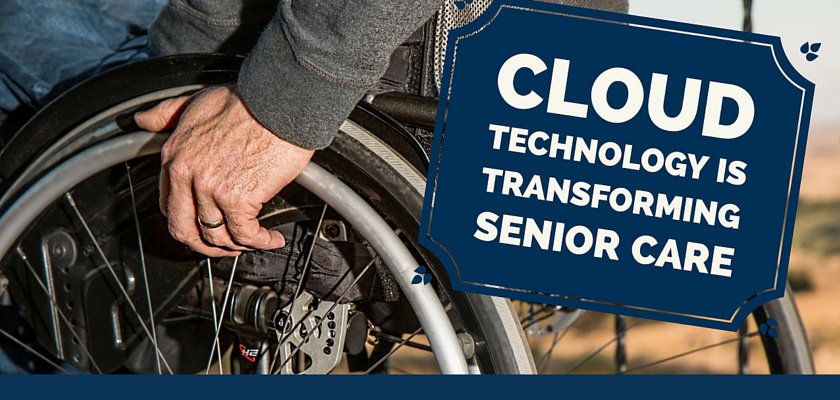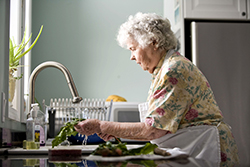How cloud technologies will enhance home-based medical care for seniors
Imagine a physician turning on a tablet to check in on a 70-year-old diabetic patient whose vital signs and other pertinent health data are being transmitted to the doctor’s office via the cloud by a wearable device attached to the patient’s wrist. No need for the elderly patient to travel to the doctor’s office, or have the patient admitted to a hospital unless it is really necessary either.

This is not a futuristic scenario. Such technology actually exists.
Developments in cloud-based technology continue to move forward in response to what has been termed the “silver tsunami” – the anticipated explosion of aging baby boomers that will need medical care in the next few years. Almost one in five of today’s boomers have diabetes, 40% are obese and more than half take prescription drugs for hypertension, according to a recent report from the Centers for Disease Control and Prevention.
The report also indicates that despite their ailments, the overall death rate of boomers has gone down over the last decade. This, however, presents the issue of providing care for them for longer periods. This poses as a challenge because many aging seniors want to avoid nursing homes and hospitals.
Care for the elderly is expected to cost US$319 billion in the United States alone this year, according to the market research firm The Freedonia Group.
The cost of a hospital stay in North America has also gone up. For example, the latest statistics from the Kaiser State Health Facts indicate that the average per day cost of hospitalization in 2014 was from $1,791 to $2,289.
 Hospitals and governments are increasingly turning to technology to develop new equipment and ways to enhance and to bring down the spiraling cost of senior medical care. One of the most promising areas is in remote monitoring of patients being taken cared for in their own homes.
Hospitals and governments are increasingly turning to technology to develop new equipment and ways to enhance and to bring down the spiraling cost of senior medical care. One of the most promising areas is in remote monitoring of patients being taken cared for in their own homes.
Technology and healthcare experts foresee growth in bio sensing, sensory networks, robotics and telecommunications devices geared towards caring for the elderly. New consumer-focused wearables that are not only capable of monitoring heart rate and body temperature but also able to detect falls, are now in the market.
“Long-term care is very expensive, but healthcare professionals are finding out that many of the conditions seniors are suffering from can be managed from their home,” according to Greg Horne, healthcare lead of analytics software maker SAS Canada. “There are now many devices that are capable of monitoring patients’ vital signs and technology exists to transmit this data over the cloud.”
The trend, he said, is moving towards making remote monitoring unwieldy and easier for non-professionals to conduct. There are still many providers that cart heavy oxygen meters or blood glucose devices to a patient’s home. However, we are now increasingly seeing smaller monitors for pulse, oxygen, blood glucose levels and blood pressure that are much smaller.
“If the patient has an acute situation, such as a myocardial infarction, we can use remote monitoring for transitional care,” according to Mark Caron, CEO of Geneia, a Harrisburg, PA-based healthcare data, and technology firm. “We can monitor the patient with a telemetry patch that sends data right to the provider’s office or hospital. If any of the measurements indicate deteriorating health, their detection triggers an alert to providers who can then deliver lifesaving interventions much earlier than they would otherwise.”
 Patients can also use data provided by such monitors to modify their behavior. For instance, an at-home monitor can provide patients with congestive heart disease the information and incentive to stay away from salty snacks that can exacerbate water retention. Monitoring can help determine if heart palpitations are signaling a heart attack or just due to indigestion. It has also been estimated that the use of body sensors reduces the cost of hospital-borne infections by $12,000 per patient.
Patients can also use data provided by such monitors to modify their behavior. For instance, an at-home monitor can provide patients with congestive heart disease the information and incentive to stay away from salty snacks that can exacerbate water retention. Monitoring can help determine if heart palpitations are signaling a heart attack or just due to indigestion. It has also been estimated that the use of body sensors reduces the cost of hospital-borne infections by $12,000 per patient.
IDC Health Insights report based on the analyst firm’s 2015-2016 Healthcare Provider Technology Spend Survey indicates that “across all of the technologies examined in the survey, providers are taking advantage of more cloud implementations and leveraging mobile and analytics capabilities in the cloud.”
While 50% of software spending growth is still directed toward on-premise investments, survey respondents reported that 18% of new software spend is going into software as a service (SaaS) and 24% is going into projects that leverage managed hosting by a third party.
Other surveys indicate that 83% of IT healthcare organizations are using cloud services. The report shows that 67% of healthcare organizations are running SaaS-based applications, with 15.9% running on infrastructure-as-a-service (IaaS) platforms and 2.4% using platform-as-a-service (PaaS) applications.
Information flowing from various sensors and monitors will generate a large amount of data that will require an approximate investment in infrastructures to handle the transmission, storage, and analysis of the data, according to Horne.
“All that data has to go somewhere and it can’t be done by hospitals alone,” he said, “So the cloud is where data will reside and where doctors can access patient information from.”
He said cloud infrastructures will be vital in handling the storage, management, protection, sharing, and transmission of data. “Governments and healthcare organizations will need to invest in cloud infrastructures.”
The use of cloud technologies in healthcare is still in its early days and among the key barrier is user attitudes towards technology. However, with the cost live-in senior care going up to as much as $6,000 a month and rising, there’s no doubt that families will adopt cloud technology if it can help reduce costs and increase flexibility with their healthcare options.
 Nestor Arellano is a Toronto-based journalist who specializes in writing about technology and business news. Nestor reports on IT trends, new products and best practices, and how these can be of use to business and IT decision makers in the enterprise, small and medium size business space, and government.
Nestor Arellano is a Toronto-based journalist who specializes in writing about technology and business news. Nestor reports on IT trends, new products and best practices, and how these can be of use to business and IT decision makers in the enterprise, small and medium size business space, and government.


